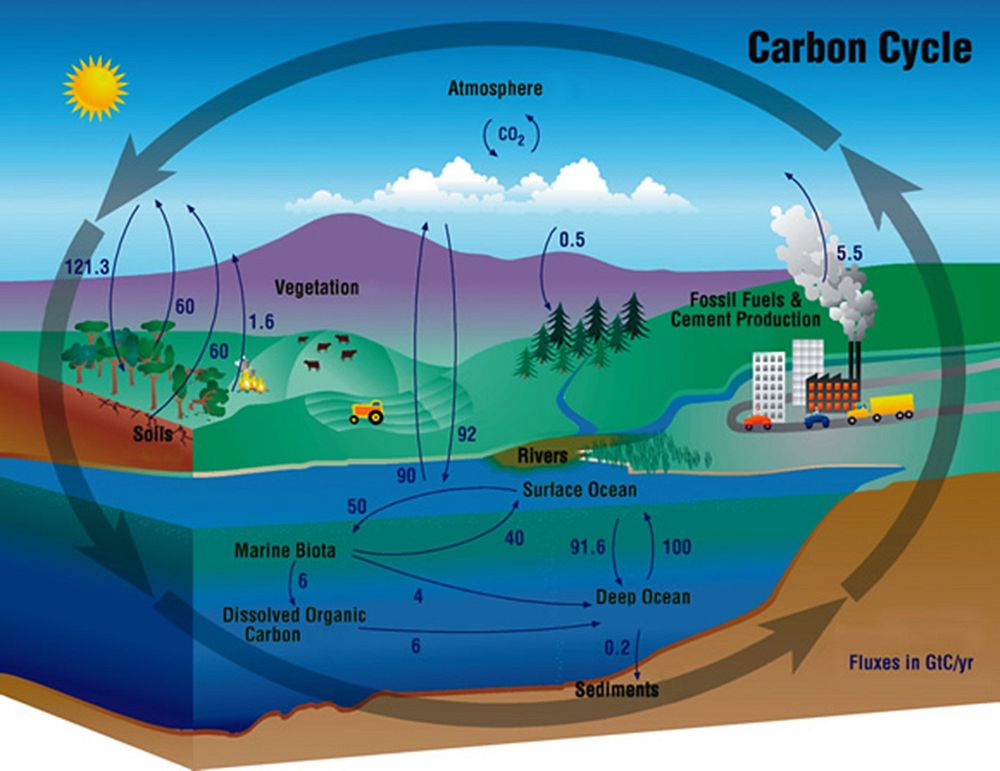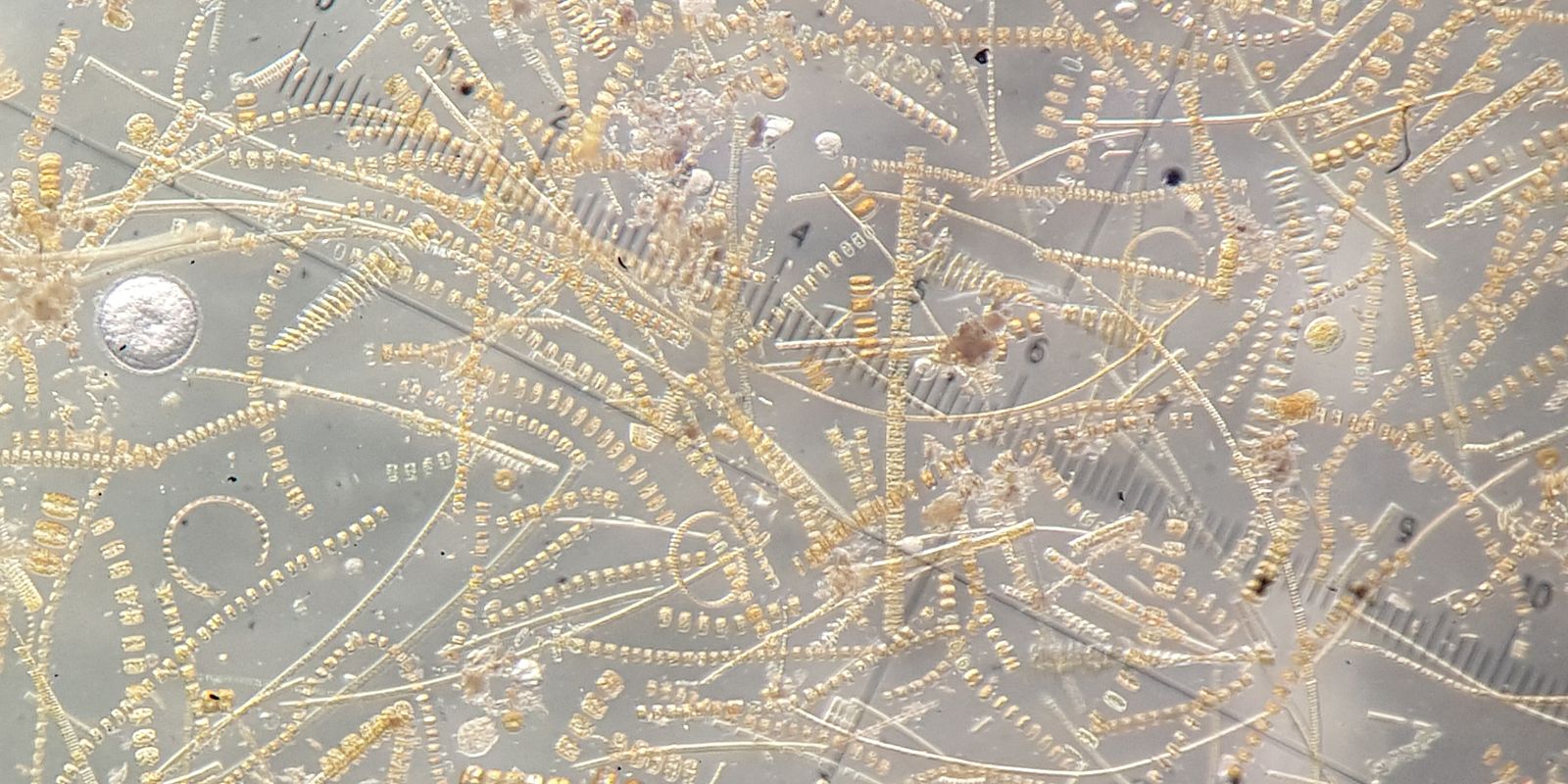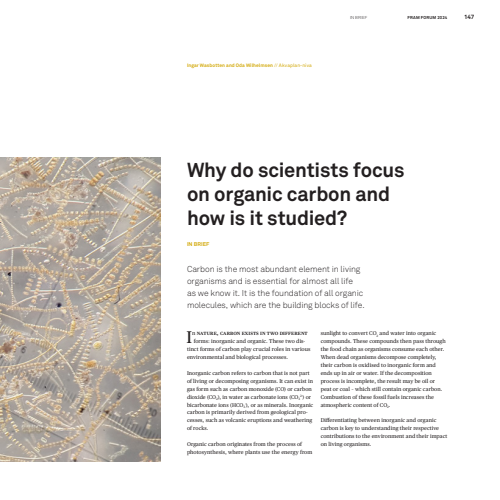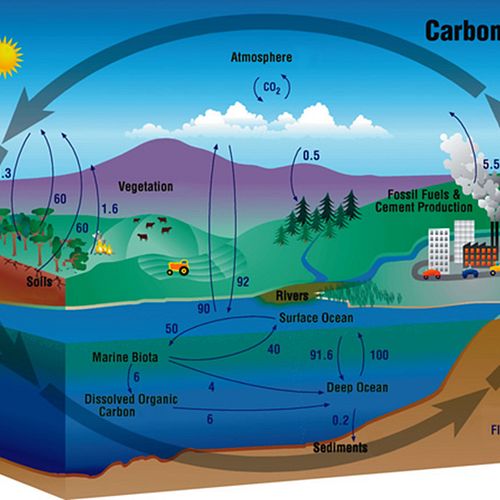4. juli 2024 nyhet
By Ingar Wasbotten and Oda Wilhelmsen // Akvaplan-niva
Carbon is the most abundant element in living organisms, and it is essential for almost all life, as we know it. It is the foundation of all organic molecules, which are the building blocks of life. In nature, carbon exists in two different forms: inorganic and organic. These two distinct forms of carbon play crucial roles in various environmental and biological processes and they are therefore of great interest to natural scientists.
Inorganic carbon refers to carbon that is not part of living or decomposing organisms. It can exist in gas form such as carbon monoxide (CO) or carbon dioxide (CO2), in water as carbonate ions (CO32-) or bicarbonate ions (HCO3-), or as minerals. Inorganic carbon is primarily derived from geological processes, such as volcanic eruptions and weathering of rocks.
Organic carbon originates from the process of photosynthesis, where plants use the energy from sunlight to convert CO2 and water into organic compounds. These compounds then pass through the food chain as organisms consumes each other. When dead organisms decompose completely, their carbon is oxidised to inorganic form and ends up in air or water. If the decomposition process is incomplete, the result may be oil or peat or coal – which still contain organic carbon. Combustion of these fossil fuels increases the atmospheric content of CO2.
Differentiating between inorganic and organic carbon is key to understanding their respective contributions to the environment and their impact on living organisms.
How is organic carbon measured?
Historically, a variety of analytical techniques have been used to measure the total organic carbon content in soil and sediments. These techniques ranged from basic measurements like colour and gravimetric analysis to more complex ones like dry and wet oxidation or spectroscopy. Below we describe a technique we use at Akvaplan-niva.
The basis of the method is dry combustion to carbon dioxide. A small sample of soil or sediment is heated up to different temperatures with different carrier gases, and the amount of carbon dioxide released at each level is measured.
First, oxygen is blown into the chamber containing the sample and heated to 400°C; organic carbon is oxidised and released as CO2. Then the carrier gas is switched to nitrogen and the sample is heated to 900°C. At this point, inorganic carbonate in the sample decomposes to CO2. Last, the carrier gas is switched back to oxygen, and any residual oxidizable carbon is combusted to CO2.
Organic carbon is released during both the first and the last step. Together, they are called total organic carbon (TOC). However, the carbon released in the first step is “bioavailable”; andcan readily be decomposed by microorganisms and serve as a source of energy and nutrients.
The carbon released in the last step comes from compounds that are more complex and resistant to decomposition and is not easily accessible to microorganisms. When the decomposition process of this fraction of organic matter is incomplete, the results may be oil, peat, or coal. Therefore, this fraction of organic matter plays a significant role in long-term carbon storage in sediment, thus contributing to the sequestration of carbon from the atmosphere.
The scientific value of TOC
TOC is a widely used parameter to assess water quality. Organic carbon in water can indicate the presence of decaying organic matter, which can contribute to oxygen depletion and affect aquatic ecosystems.
TOC is also commonly used to study soil fertility. The organic carbon in soil plays a vital role in soil structure, water retention, and nutrient cycling, as well as being the main source of energy for soil microorganisms.
Environmental scientists are mainly interested in the carbon that moves through the carbon cycle. Sediment and soil concentration of organic carbon and organic load are very well correlated and therefore, organic carbon can be used as a tool for tracking environmental load and give an indication of contamination level.
Bioavailable or not?
Bioavailable organic carbon represents the portion of organic matter that microorganisms can use. Microbial activity in turn affects nutrient cycling, sediment biogeochemistry, and the overall health of the environment. Non-bioavailable carbon, on the other hand, plays a significant role in long-term carbon storage in sediments, contributing to the sequestration of carbon from the atmosphere.
Differentiating between bioavailable and non-bioavailable organic carbon in sediments is crucial for understanding the potential for carbon degradation and its impact on the environment. Moreover, the relative amount of bioavailable versus non-bioavailable carbon has implications for important biogeochemical processes.
Carbon degradation and nutrient cycling: Bioavailable organic carbon fuels microbial activity; organic matter is broken down and nutrients are released back into the soil or water column. This nutrient cycling supports the growth of phytoplankton and other primary producers, forming the foundation of the food web.
Carbon sequestration: Non-bioavailable organic carbon acts as a long-term carbon pool and a link between the rapid and the slow parts of the carbon cycle. For example, carbon in sediments can end up being stored over geological timescales. This contributes to removing CO2from the atmosphere and mitigates climate change. By measuring the amount of non-bioavailable organic carbon, one can estimate the carbon sequestration potential of marine sediments.
Understanding the dynamics of bioavailable and non-bioavailable organic carbon fractions is crucial for informed decision-making in marine management and conservation.
Environmental surveys
In environmental surveys in Norway, it is common to determine total organic carbon in soil and sediments, but usually no distinction is made between bioavailable and non-bioavailable organic carbon. The fact that the total carbon content is high does not necessarily mean that it is bioavailable, or that the sediments are influenced by anthropogenic input. Therefore, one should determine the proportion of bioavailable organic carbon, and consider it in relation to total organic carbon when assessing the condition of sediments or soil.
Changes in the bottom fauna communities are good indications of unwanted organic loads. Under natural conditions, benthic communities typically consist of many species. Species diversity is dependent on, among other things, favourable conditions for the fauna.
However, even moderate changes in organic load can result in less favourable conditions, allowing opportunistic species to outcompete more sensitive species, resulting in reduced species diversity. Changes in species diversity near emission points (eg fish farms, sewage outflows) can largely be attributed to changes in the organic content of the sediment.
In conclusion, by looking at not just total organic carbon, but also its bioavailability, scientists can get a deeper understanding of ecosystems, and how organic load affect them.

The carbon cycle describes the movement of carbon atoms between the atmosphere, hydrosphere, biosphere and lithosphere. Carbon cycling in and out of the biosphere is rapid, on the order of 1-50 years. Carbon cycling involving the lithosphere is far slower, taking from hundreds to millions of years. Graphic: NASA
This article has previously been published in Fram Forum: https://framforum.com/2024/03/...



